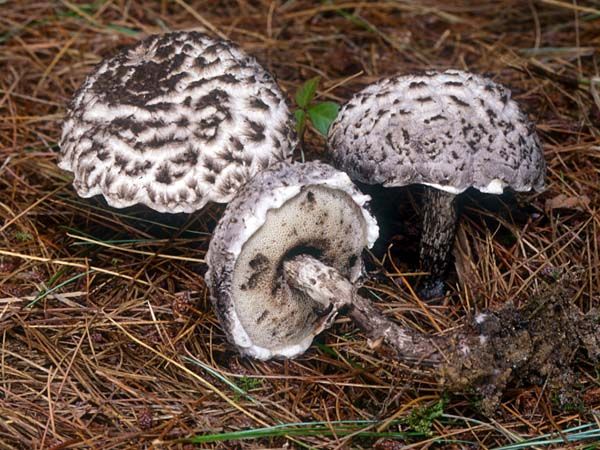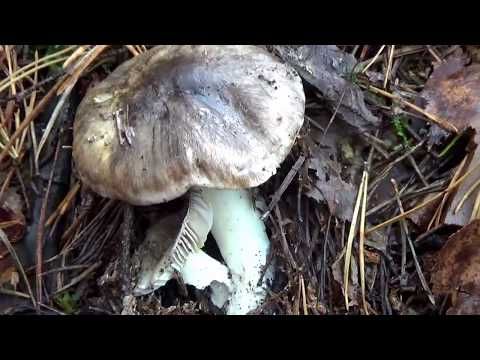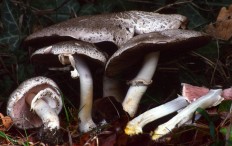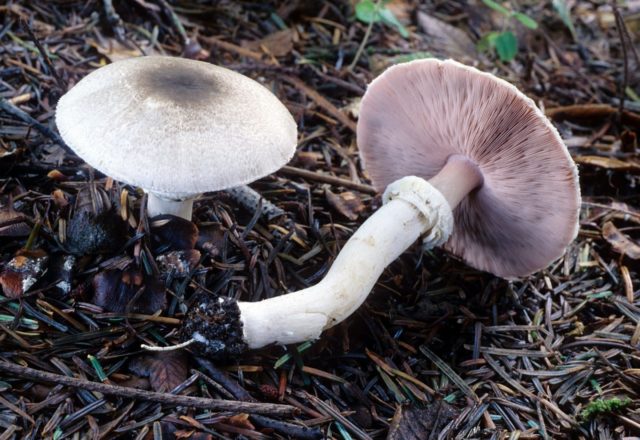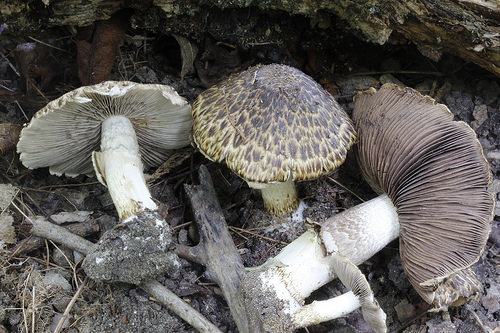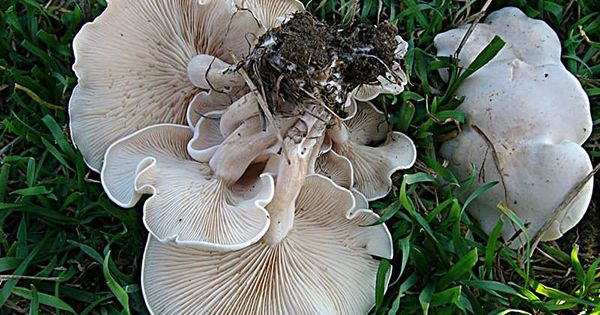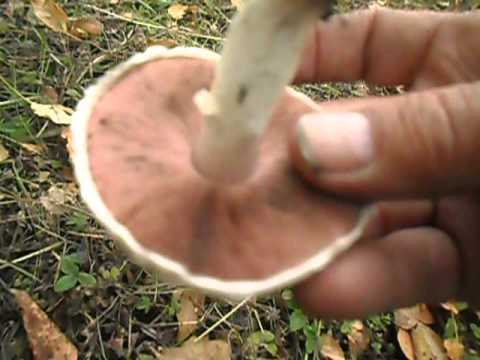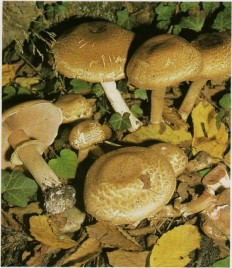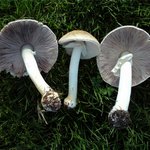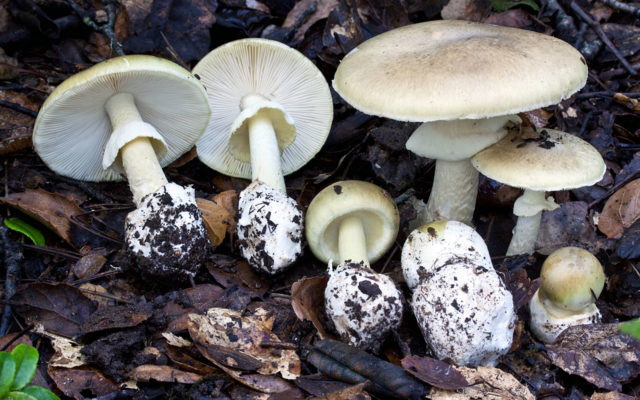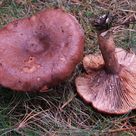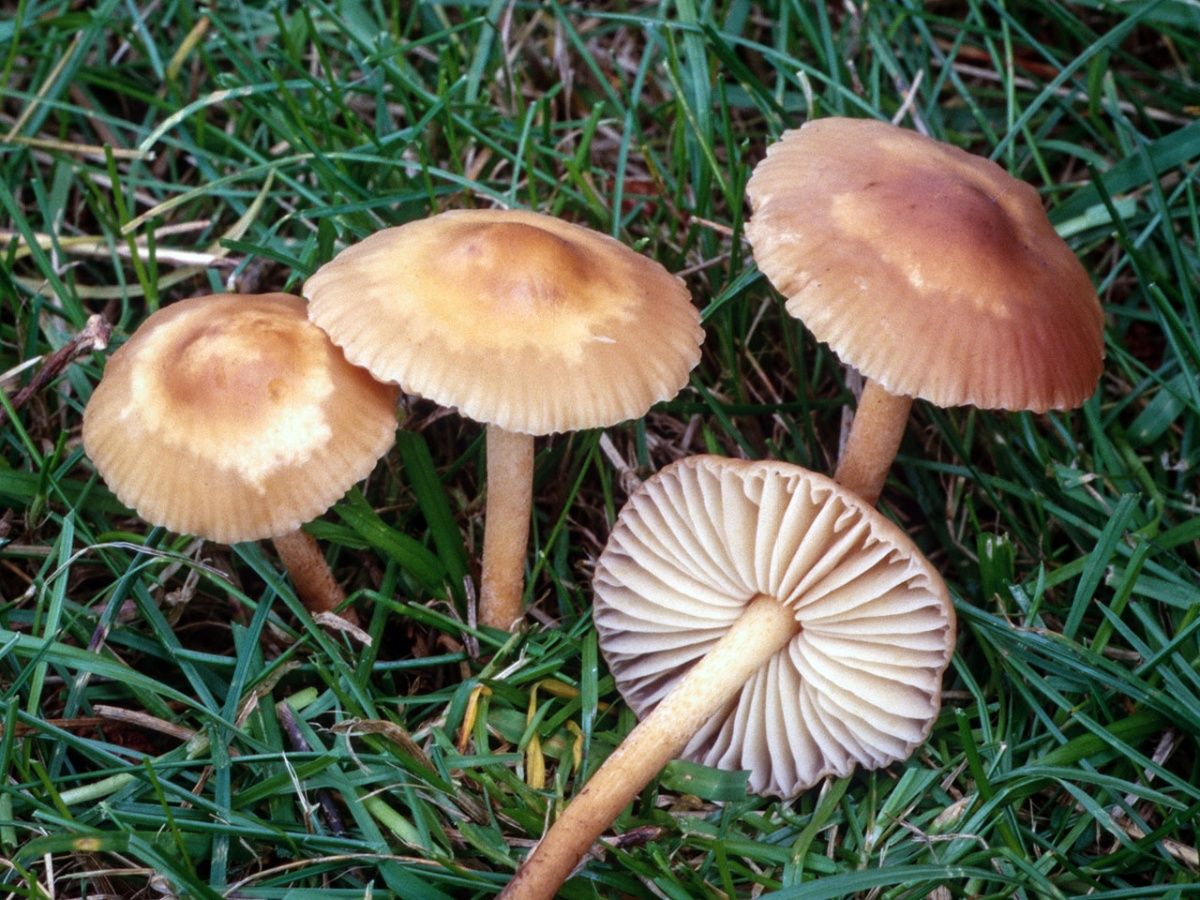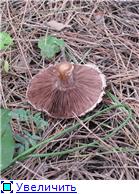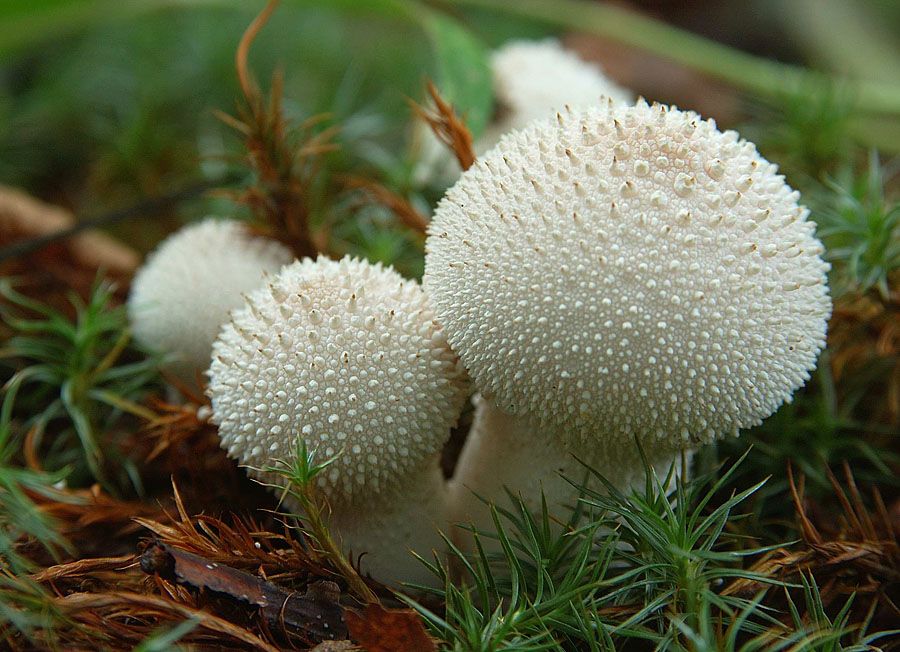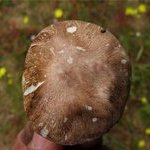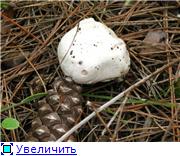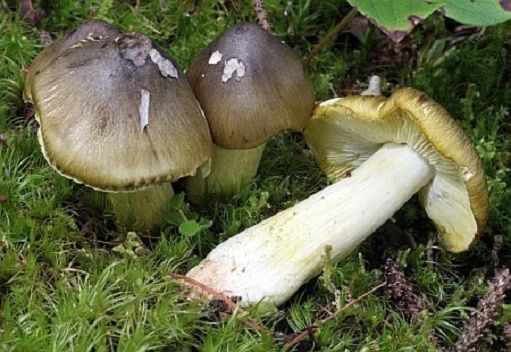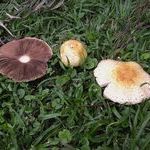Description
Steam champignon (greenhouse) probably got this name, as it prefers organic-rich soil, which is found in vegetable gardens and, in particular, in greenhouses.
Hat
Reaches 8 or 10 cm in diameter. It is painted in brownish-red tones, with rare and large scaly formations on the surface. Its shape in the process of maturation and growth changes from bell-shaped to almost flat. The surface is usually dry, but can become tacky in particularly humid weather.
Leg
It is characterized by a white color. In young mushrooms, it is dense, and becomes hollow when ripe. Also, in young specimens, it is fibrous, and then it becomes completely smooth. The length of the leg reaches 10 cm. There is a single ring on it, the edges of which sag significantly downward. The leg, as a rule, has a thickening from top to bottom.
Spore-bearing layer
Presented by plates. They are narrow and frequent, do not have a rigid fixation to the stem. Their color in youth is reddish, then acquires a chocolate brown tint.
Pulp
The mushroom has a persistent cyclonic pulp smell at any age. The color turns reddish when cut from white. The consistency is quite firm and firm.
Description, taxonomy and characteristics of the edible mushroom
Field mushroom, common or sidewalk has the Latin name Agaricus arvensis, belongs to the mushroom genus of the mushroom family. There are a number of synonyms in Latin: Psalliota arvensis, Pratella arvensis, Fungus arvensis, Psalliota campestris. In England, it is often called the horse mushroom due to the fact that this species prefers to grow on horse farms near dung heaps.
The hat is thick, fleshy, rounded, somewhat reminiscent of the shape of a bell, the edges are wrapped inward, there is a thick veil that covers the lower part. As it grows, the cap opens, acquires a spread shape, a small tubercle remains in the center, the remains of the bedspread can hang down along the edges. In diameter it reaches 20 cm, the color is white, less often cream, in older specimens an ocher tint appears. Touching it causes yellowing of the surface, but this process is quite slow. The cap is covered with fibers or scales, they are often yellowish, and can crack in drought.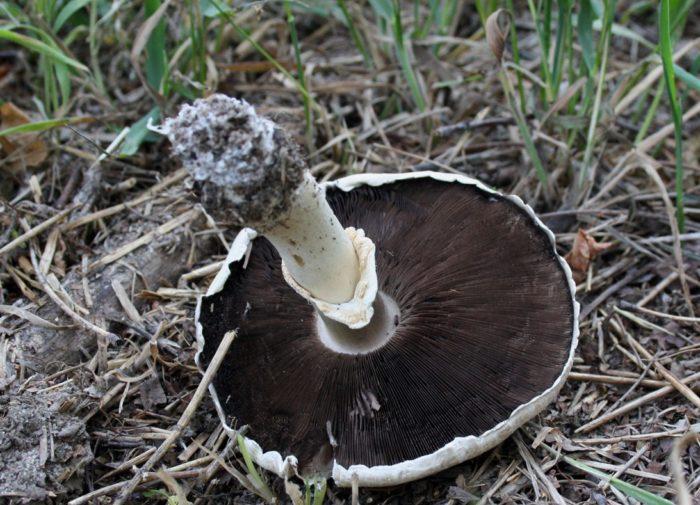
The lower part of the mushroom cap is called the hymenophore; in the champignon it has the form of plates, which are often located, slightly swollen, wider to the edges, and free to the center. Width - up to 12 mm, white, darken with age and gradually acquire grayish, then brown and at the end almost black shades. Spores are dark brown.
The flesh of the champignon is dense, in the old fruits it becomes soft, it tastes sweet. A subtle yellow tint appears on the cut. There is an anise or almond aroma, it is most pronounced in young fruits.
The leg reaches a height of 10 cm, and up to 1.5 cm in diameter, the shape is cylindrical, the surface is smooth, it can slightly expand towards the base. The ring on the leg is wide, white, two-layer, located in the upper part. There is also a lower ring, shorter and yellowish, serrated. The pulp of the leg is fibrous, in old fruits it acquires a small cavity, it is easily separable from the cap. At the base there is a plaque in the form of flakes. It repeats the color of the cap, it also turns yellow from pressure, and the shade does not change in the lower part.
A bit of history
For the first time, the German scientist-mycologist Jacob Christian Gottlieb Schaeffer wrote about the field champignon in 1774. New research was carried out in 1999, which identified two morphotypes of this fungus, possibly representing different species. They differ in the shape and shade of the cap, especially in adulthood.
Growing at home and in the country
Champignons are the most popular mushroom in cultivation and cultivation on an industrial scale.Only mushrooms can compete with him. Peppers can be planted in the country, in bags, containers, in a greenhouse and even in an apartment.
Here's what you need in order to breed common champignon, because growing it is not as difficult as it might seem at first glance:
- prepared substrate of straw and poultry manure, but ready-made soil can be purchased;
- create a closed bed 40 cm deep into the ground. The walls and lid are made of planks and insulated with polystyrene foam. The height of the entire structure is not lower than 70 cm;
- put compost in 2 layers, tamp well;
- measure the temperature inside the soil, because it is possible to sow mycelium only when the earth warms up to 22 degrees;
- mycelium - can be purchased at specialized stores.
How to grow peppers in the garden:
The acquired mycelium is stored in the refrigerator and kept at room temperature a day before planting.
The mycelium is laid out on a litter and planted in a garden bed to a depth of 7 cm in pieces in a checkerboard pattern. No more than 500 grams of mycelium are sown per 1 m2.
The first shoots will appear in 10 days. At this time, it is necessary to loosen the casing layer.
The collection is carried out carefully so as not to damage the nearby rudiments of new fruits
The mushroom is taken by the leg and carefully twisted.
The formed depressions are covered with earth.
After harvesting the first crop, the covering soil should be watered. It should be remembered that for mushrooms, dryness is better than excess moisture.
Views
The forest mushroom has several related inedible species, with which it is confused. The following similar species are characteristic of the false forest champignon:
- NS. flat-cap;
- NS. variegated, or w. Möller;
- NS. redhead, or w. yellow-skinned.
They grow in deciduous and mixed forests, in the same place as the edible species of forest mushroom, outwardly they almost do not differ.
The difference between edible and inedible mushrooms
False doubles are successfully camouflaged in parks and meadows, starting in July
They have some features that are important to focus on. Their description:
- less dense pulp;
- a leg on a fracture of a poisonous yellow color;
- the aroma is specific, medicinal.
In some cases, forest mushrooms are confused with even more dangerous forest inhabitants: with pale toadstool and with white amanita. These are deadly poisonous mushrooms. In a toadstool, unlike champignons, the plates are whitish, with blueness. On the break, the pulp is colorless. At the base of the toadstool's leg there is a saccular thickening - a volva.
Light fly agarics are similar in color to edible forest organisms. Their legs in the Volvo, like in a small pot, the plates do not change color with age.
When harvesting, it is important to carefully examine all specimens immediately on the spot and not put suspicious or unfamiliar ones in the basket.
Edible species
Eat only edible mushrooms
The genus Champignon (Agaricus) has several edible species that grow in nature. These include ordinary, field, meadow, Bernard, dark red, curves, double-pore, etc.
Champignon double-peeled: can be found in places where there is no grass and leaves on the ground. Its description:
- a hat with edges bent along the edge;
- hanging remnants of a private bedspread are visible on the edges of the cap;
- color from brown to white;
- juicy and dense pulp;
- young plates are pink, old ones are reddish-brown with a lilac tint;
- smooth cylinder-shaped leg.
Older individuals have light or whitish-brown legs. Its height reaches 10 cm and its diameter is up to 4-5 cm. There is a formation in the form of a ring under the cap.
- Curved champignon: the species is characterized by an uneven stem with a thickening from top to bottom. A medium-sized cap turns from an ovoid to a flat one with age. The pulp is underneath a thin beige skin. It has fibers, pale white. The plates are frequent and free; with age, they turn from white to black in color.
- Champignon dark red: a direct relative of w. ordinary (w. field).Outwardly, forest mushrooms are similar to him, but somewhat smaller. The scales in red look brighter and more noticeable. Young specimens are distinguished by pink plates.
- scaly surface of the cap;
- the size of the cap circumference - up to 15 cm;
- the height of the leg reaches 13-14 cm;
- the shape of the leg is cylindrical;
- plates are frequent;
- the pulp is clean and white;
- the ring is single-layer, thinned towards the edges.
A beautiful beige smooth hat, curved upwards, gradually becomes flat and cracked. It is fleshy and smooth. Bernard's champignon has a double - edible sh. two-ring, or w. sidewalk (Agaricus bitorquis), which has a double ring on the leg and a slight sour smell and taste.
Growing at home and in the country
It is possible to breed these fruits both at home, having allocated a dark ventilated corner for this, and in the country, by setting aside a plot in a shaded place under the open sky. The key is to use the right technology in every case.
For cultivation in the country you need compost. The first step in soil preparation is to soak dry straw (grass) in water. This process takes approximately four days. Then you need to collect manure and spread it on a layer with wet straw. Every four days, the tightly compacted layers must be shoveled. After 15-17 days, the compost is ready for sowing.
The next step is to transfer the prepared substrate into a container (for example, into a wooden box). The layers need to be poured with mycelium, then everything must be mixed and compacted. Then water and take to the darkest place of the site. After a couple of days, when a white mycelium net appears, you can sprinkle it on top with a thin layer of a mixture of earth and peat (in half).
If all the procedures are performed correctly, then on the 25–35th day the heads of the first mushrooms will appear.
In order to grow mushrooms at home, you will at least need a basement or cellar.
You need to grow fruits in the same boxes and with the same soil as in the summer cottage method. But it's worth noting that the basement cultivation method is more painstaking.
The first condition is good ventilation. The decomposing compost gives off a large amount of carbon dioxide, which is very much disliked by royal mushrooms. If necessary, you will have to buy an air filter.
The second is lighting. Many people think that special lighting is needed for optimal mushroom cultivation, but this is not the case. Light does not play a big role in this process.
The third is temperature and humidity. In summer, the required heat level can be regulated by ventilation. But to maintain high humidity, you need to periodically spray the contents of the boxes. It is better to purchase instruments for accurate measurement of all indicators, because the further harvest will depend on this.
Evaluation of taste, medicinal properties, benefits and possible harm
Royal mushroom has many useful trace elements, the use of which has a positive effect on the body. The medicinal properties of the mushroom:
- improves appetite;
- prevents the formation of blood clots;
- reduces the risk of heart attack;
- relieves inflammation;
- improves brain function;
- has an expectorant effect;
- accelerates the work of the digestive tract.
This species contains a substance such as chitin in the pulp. It is not absorbed by the body, so the royal mushrooms are poorly digested, they are classified as heavy food. For this reason, you should not feed mushrooms to children under 12 years of age. There are also a number of diseases in which it is better to refrain from using them:
- ulcer;
- pancreatitis;
- stomach upset;
- flatulence;
- cholecystitis;
- enterocolitis;
- hepatitis.
Raw royal champignon is a dietary product containing only 27 calories per 100 grams of weight.
Cossack champignon (Agaricus sylvicola)
Synonyms:
Coppice champignon (Latin Agaricus sylvicola) is a mushroom of the mushroom family (Agaricaceae).
Hat:
Color from white to cream, 5-10 cm in diameter, first spherical, then prostrate-convex. Scales are practically absent.The pulp is relatively thin, firm; anise smell, nutty taste. When pressed, the cap readily takes on a yellow-orange color.
Plates:
Frequent, thin, free, when the mushroom ripens, it gradually changes color from light pink to dark brown.
Spore powder:
Dark brown.
Leg:
5-10 cm high, thin, hollow, cylindrical, slightly widening at the base. The ring is strongly pronounced, white, can hang low, almost to the ground.
Spreading:
Coppice champignon grows singly and in groups in deciduous and coniferous forests from June to late September.
Similar species:
It would be a big mistake to mistake the pale toadstool (Amanita phalloides) for the champignon. This, one might say, is a classic of toxicology. Nevertheless, the main differences between champignons and representatives of the genus Amanita should be known to every young mushroom picker. In particular, the plates of the pale toadstool never change color, remain white until the end, while in champignons they gradually darken, from light cream at the beginning to almost black at the end of their life path. So if you find a small lonely champignon with white plates, leave it alone. This is a poisoned pale toadstool.
It is much easier to confuse Agaricus sylvicola with other members of the mushroom family. Agaricus arvensis is usually larger and does not grow in the forest, but grows in the fields, in gardens, in the grass. Poisonous Agaricus xanthodermus has a strong unpleasant odor (which is described differently everywhere - from carbolic acid to ink), and does not grow in the forest, but in the field. You can also confuse this species with the crooked champignon or, otherwise, "distinctly nodule" (Agaricus abruptibulbus), but the latter is somewhat thinner, higher, does not turn yellow so readily, and is less common.
Edibility:
Cossack Champignon - This is a good edible mushroom that rivals the best of champignons.
Video about mushroom champignon coppice
Remarks Still, it remains unclear how to distinguish between numerous similar types of champignons, even if professionals cannot agree on this. On the one hand, the mind prompts you to focus on the habitat. On the other hand, this is fully justified only for mycorrhizal fungi, and champignons, like all saprotrophs, in principle can grow everywhere, if there would be fertilization.
Field champignon (Agaricus arvensis)
Other names:
Fruit body: Cap with a diameter of 5 to 15 cm, white, silky-shiny, for a long time hemispherical, closed, then prostrate, drooping in old age. The plates are curved, white-grayish in youth, then pink and, finally, chocolate-brown, free. Spore powder, purplish brown. The leg is thick, strong, white, with a two-layer hanging ring, its lower part is broken in a ray-like manner. It is especially easy to distinguish this mushroom at a time when the coverlet has not yet moved away from the edge of the cap. The pulp is white, yellowing when cut, with an anise smell.
Season and place:
In summer and autumn, field champignon grows on lawns and glades, in gardens, near hedges. In the forest, there are related mushrooms with the smell of anise and yellowing pulp.
It is widely distributed and grows abundantly on soil, mainly in open spaces overgrown with grass - in meadows, forest glades, along roadsides, in clearings, in gardens and parks, less often in pastures. It is found both on the plain and in the mountains. Fruiting bodies appear singly, in groups or in large groups; often form arcs and rings. Often grows next to nettles. It is rare near trees; the exception is spruce. Distributed throughout Russia. Common in the northern temperate zone.
Season: from late May to mid-October-November.
Similarity:
A significant part of the poisoning occurs as a result of the fact that the field mushroom is confused with the white fly agaric.
You should be especially careful with young specimens whose records have not yet turned pink and brown. It looks like a sheep and poisonous red mushroom, as it is found in the same places
Poisonous Yellow-skinned Champignon (Agaricus xanthodermus) - a smaller species of champignon, is often found, especially in the plantings of white acacia, from July to October. Differs in an unpleasant ("pharmacy") smell of carbolic acid. When broken, especially along the edge of the cap and at the base of the leg, its flesh quickly turns yellow.
It has similarities with many other mushroom species (Agaricus silvicola, Agaricus campestris, Agaricus osecanus, etc.), differing mainly in larger sizes. Most similar to it is the curve champignon (Agaricus abruptibulbus), which, however, grows in spruce forests, and not in open and light places.
Rating: Excellent edible mushroom. Many mushroom connoisseurs prefer it to all other mushrooms.
Note: Known as Horse Mushroom in English; perhaps due to the fact that this mushroom often grows near stables, on manured soil.
Growing at home and in the country
The most common mushrooms have long been learned to grow in greenhouses, cellars and garden beds.
It is very important for them to prepare high-quality compost:
- Take 6 kg of straw and 4 kg of manure.
- Lay everything in a prepared hole in layers.
- Water every day and turn with a pitchfork once a week.
- After three weeks, the compost is ready.
The time may vary depending on the feedstock and air temperature, but as soon as the ammonia odor disappears, the mixture can be used. The compost is spread on the beds.
The mycelium itself is best purchased from a responsible seller. When grown outdoors, choose the most shaded area:
- The soil is slightly fluffed.
- Plants, grass, roots should be left, they will help the mycelium to form.
- Sprinkle the surface with mycelium and cover with prepared compost.
- Water as needed.
The first crop, as a rule, emerges after 2.5 months. Sowing can be done in spring, summer or autumn. In winter, the mycelium is covered with fallen leaves and needles.
Interesting Facts
Peppers are excellent sources of protein and are good to include in your weight loss diet. If you reinforce it with active physical activity, weight loss will go faster.
Japanese scientists have published data confirming the high content of arginine and lysine in bread. These are special substances that have a beneficial effect on a person's mental abilities, helping to maintain good memory and mental clarity in old age.
In terms of phosphorus content, champignons are not inferior even to seafood.
There are more B vitamins in peppers than in young vegetables.
Champignon meadow or field champignon is a versatile mushroom that can be grown in a personal plot, in a greenhouse and even at home. Fans of quiet hunting, who prefer forest fruits, need to know how an edible mushroom should look like, and how it can differ from its poisonous counterparts, so as not to harm their health.
Evaluation of taste, medicinal properties, benefits and possible harm
The calorie content of fresh peppers is 27 kcal per 100 grams of product. Fresh mushrooms contain a whole list of vitamins B, E, PP and others. In addition, they also contain useful trace elements: calcium, potassium, manganese, zinc, copper, iron, phosphorus, about 20 essential amino acids. The high-quality protein found in mushrooms is an excellent alternative to meat protein, which the body uses to build cells.
Other useful properties of champignons:
- normalization of the activity of the cardiovascular system;
- lowering the level of "bad" blood cholesterol;
- removes salts of heavy metals;
- mushrooms contain antioxidant substances that fight free radicals.
- mushroom infusion is used to treat wounds;
- in the treatment of diabetes mellitus to lower blood sugar levels;
- folk healers used oven extract to fight typhoid fever.
Doctors warn that it is forbidden to eat any mushrooms for children under 12 years old, pregnant and lactating women, people with exacerbations of chronic diseases of the gastrointestinal tract. Do not forget that mushrooms contain chitin (especially a lot of it in the legs), which is very difficult to digest. Mushrooms are a sponge, they quickly absorb salts of heavy metals, pesticides and nitrates, harmful substances. You should not pick mushrooms near major roads, factories and factories. This is not necessary, because today in stores there is a huge selection of safe bakers grown in an industrial environment.
Distribution and collection
Champignon august is widespread throughout the forest belt of Europe from Scandinavia to the Urals, preferring coniferous forests with rich soil, mainly with a predominance of spruce.
Often found in parks and forest parks, often the August mushroom can be found near anthills or growing directly from them. This is due to the fact that many species of ants cultivate champignon, as we do, eating and feeding the offspring with special tuberous formations on hyphae (ants do not use fruit bodies and try to prevent their appearance).
The August champignon is found most often in small groups, but grows in whole “villages” on favorable soils.
Cooking recipes
You can cook field mushrooms without much effort: they are pickled, fried, fermented, salted, roasted, used in fillings, etc.
Primary processing
After collecting, the mushrooms should be rinsed under running water, cleaned of debris and removed from the top of the cap, which can be easily removed.
Cooking
These fruits are not always boiled, only for making salads, soups or pickling. In other cases, you can use raw mushrooms. Cooking is carried out for no longer than 10 minutes in slightly salted water, then the mushrooms are removed and the liquid is allowed to drain.
Pickling
For the long-term preservation of mushrooms, a rather old method is used - fermentation. It is more harmless to the body than pickling, but the taste of champignons also becomes specific. For cooking you will need to take:
- boiled mushrooms - 1 kg;
- sugar - 30 g;
- salt - 80 g.
How to make field mushrooms for the winter:
- Sprinkle champignons with sugar and salt, mix.
- Put the mass in a saucepan, press down on top with oppression.
- If, after a day, little brine has formed, then you can add water so that the mushrooms are completely covered.
- Remove the container in a warm place, but not warmer than 20 degrees.
You can eat such fruits after a week, and should be stored in closed jars in the refrigerator or basement. They will become most delicious after a month.
Important! All containers and cargo are best sterilized before use.
Pickling
There is a quick way to get delicious pickled field mushrooms, for this you need to cook:
- mushrooms - 1 kg;
- vinegar - 5 tbsp. l .;
- salt - 2 tsp;
- sugar - 2 tsp;
- black peppercorns - 20 pcs.;
- garlic - 7 cloves;
- vegetable oil - 2 tbsp. l .;
- laurel leaves - 2 pcs.
Cooking process:
- Put all the ingredients in a saucepan and put on fire, adding a glass of water. You can crush the garlic slightly.
- Bring to a boil over low heat.
- Remove after 7 minutes.
The mushrooms are ready, it remains to cool them, put them in a jar and pour in the marinade. They should be stored in the refrigerator, but, as a rule, they will not stay there longer than a day.
Freezing
To freeze the mushrooms, it is enough to carry out the initial processing and decompose in portioned bags. If desired, you can boil for no more than 10 minutes and also freeze in portions.
Frying
It is enough to peel and wash the field champignon, remove the film from the cap and cut into convenient slices. They are fried with the addition of vegetable oil. These mushrooms are delicious even as an independent dish, without adding other ingredients, if desired, you can add onions.
Salting
For cooking you need to take:
- mushrooms - 1 kg;
- dill - 100 g;
- garlic - 10 cloves;
- salt - 5 tbsp. l .;
- sugar - 1 tsp
Cooking process:
- Pour boiled mushrooms with water so that it covers them by 1 cm.
- Add spices. Cut the garlic into wedges. Tear the dill with twigs.
- Cover with a plate and place the load. After a day, put in the refrigerator for a week.
- Transfer everything to a jar and store in the same brine.
Mushrooms can be served or rinsed before serving to get rid of excess salt.
Drying
It is easy to dry the mushrooms, it is enough to peel and cut them into slices. Mushrooms should not be washed before drying. You can dry it by stringing it on a thread and covering it with gauze from insects. The fruits are hung out in a sunny, well-ventilated place. It takes 2-3 days for the mushrooms to reach the desired state.
Canning for the winter in banks
You will need:
- field champignon - 2 kg;
- water - 0.5 l;
- salt 1 tbsp. l .;
- sugar - 1.5 tbsp. l .;
- citric acid - on the tip of a knife;
- allspice - 7 pcs.;
- white pepper - 7 pcs.;
- cloves - 8 pcs.;
- a pinch of rosemary and thyme.
Cooking process:
- Boil the mushrooms with the addition of salt and citric acid.
- Strain, drain the liquid and put in prepared jars, pressing a little with your hands.
- In the meantime, prepare the marinade with the listed ingredients. Cook it for 10 minutes on low heat.
- Then immediately poured into jars with fruits in a thin stream.
The jars are closed with tight lids, covered with a blanket. After complete cooling, they are removed to the basement or closet.
Similar species
Due to its particularly large size, large-spore champignon is difficult to confuse with other species, but young specimens may look like some edible mushrooms:
The main difference is that this species is predominantly forest, and it grows mainly among the pines. It looks like it has a significant thickening of the base of the leg. By maturity, the hymenophore of fungi of this species acquires a black and red coloration, while in large spore it remains brown.
Most similar view. He is also large and prefers open spaces. Some sources even consider the large-spore champignon to be a species of field mushroom (Psalliota arvensis subsp. Macrospora), so there are no clear differences between them.
1-Champignon curve 2-Field champignon
Yellow-skinned champignon
In addition to harmless, edible species, there is also a poisonous double - this is Yellow-skinned or false champignon. It stands out with a distinct smell of gouache paint. Has a yellowish coloration of the base of the leg.
Also, young specimens may look like toadstools or fly agarics. Champignon can distinguish colored plates and slight reddening of the flesh when cut from the pale toadstool and the smelly fly agaric.
Thus, some doubles of the large-spore champignon can be very dangerous.
Therefore, you should pay attention to a number of their distinctive properties.
Description
Hat
The average diameter is from 5 to 10 centimeters, but it happens that it reaches 15 cm. At the beginning of growth, the shape of the cap is ovoid, later it straightens and takes the shape of a saucer. From above, the cap is covered with large grayish-brown scales, the surface is fibrous to the touch, especially in the middle. When the flesh of the cap is pushed, it turns red, then turns brown.
Leg
About 1.5 cm in diameter, up to 10-12 in height, in large specimens - up to 15 cm. The surface is scaly, fibrous, painted white or grayish. The shape is cylindrical, often curved. In a young mushroom, the leg is solid, as it matures, cavities appear, then the leg becomes hollow. In the upper part there is a well-distinguishable leathery ring that disappears as the mushroom ages.
Pulp
Brittle, white, at the site of a break or cut, it turns red almost instantly. With a pleasant slightly sweet taste and mushroom aroma.
Spore layer
Lamellar, the frequency of the location of the plates is average. At a young age of the fungus, the plates are light pink, as they grow, they acquire a red hue, and in the old fungus they become dirty brown, turning into black.Spore powder chocolate, round, smooth spores.
Description
Hat
Sizes reach from 5 to 15, sometimes up to 20 centimeters. The shape of the cap is in the form of a hemisphere, closed, over time it straightens out and becomes convex-outstretched. On the edges of the cap, scraps of a membranous veil covering the hymenophore (spore-bearing layer) are visible.
The skin color is yellowish or golden in color, dull brown scales are located over the entire surface, in youth they are orange-brown, towards the center of the cap they become more frequent and almost completely cover the skin. A mature mushroom often has a well-defined tubercle in the center of the cap.
Spore-bearing layer
Lamellar. In a young fungus, they are covered with a filmy blanket, which creates a favorable environment for the maturation of spores. Subsequently, the film breaks, hanging in fragments at the edges of the cap and forming a characteristic filmy ring on the stem.
The plates are located often, freely, at the beginning of the mushroom growth they have a white-cream color, gradually darkening to brown with a chocolate tint. The spore powder is also brown.
Leg
The leg thickness is about 2, sometimes 3 centimeters, rather long, about 10-15 centimeters. The surface of the peduncle is rough, scaly, white or yellowish-grayish, with a slight thickening at the base. The flesh of the leg turns yellow when pressed, oxidizing in air.
Pulp
Dense, rather elastic, more brittle in the cap, hardening in the stem as the mushroom ages. The aroma is described in different ways, some consider it to be similar to the smell of aniseed, some compare it to the root of calamus, some - with an almond scent. The taste of the pulp is a little pungent, mushroom, pleasant. On a break or cut, the flesh becomes pink or reddish in color.
Field champignon: description of appearance and photo
Category: edible.
In 1762, the field champignon (Agaricus arvensis) was singled out into a separate group by the professor of the Wittenberg and Tübingen Universities, Jacob Scheffer, a botanist, ornithologist and entomologist.
In appearance, the field mushroom is slightly different from other species. Hat (diameter 7-22 cm): white, gray, cream or light ocher (in old mushrooms) with remnants of the coverlet. It has the shape of a small egg or bell, but over time becomes almost prostrate with a noticeable tubercle in the center. The edges of young mushrooms are wrapped inward, and later become wavy. In dry weather, they can severely crack, due to which they become uneven and torn. Smooth to the touch, in rare cases it may have small scales. Stem (height 5-12 cm): usually the same color as the cap, turns yellow when pressed, fibrous, cylindrical and has a large double-layer ring. Often tapers from bottom to top. In young mushrooms, it is solid, but becomes hollow over time. Easily detaches from the cap.
Plates: can be white-gray, brownish, with a mustard or purple tint, in old mushrooms they are dark brown or black.
Flesh: white or light yellow, very firm, turns yellow on the cut and on contact with air. Tastes sweet.
The description and photo of the field mushroom are similar to the description and photo of the pale toadstool (Amanita phalloides) and the yellow-skinned mushroom (Agaricus xanthodermus).
However, the toadstool has no aniseed scent and has a single-layer ring on the stem. And the yellow-skinned champignon has a strong medicinal smell of carbolic acid.
Field mushrooms grow from late May to early November in the northern regions of Russia.
Where it can be found: In open areas of forests, fields and pastures, it can be found in mountainous areas, nettle thickets or near fir trees. Large groups of field mushrooms sometimes form "witch's rings".
Eating: both fresh and after any kind of processing. A very tasty mushroom, in many countries it is considered a delicacy.
Application in traditional medicine (data have not been confirmed and have not undergone clinical trials!): In the form of an extract as an effective remedy in the treatment of diabetes mellitus.Broths have been used since ancient times in the outback as an antidote for snake bites.
Important! Field mushrooms often accumulate heavy metals. Cadmium, copper and other elements in high doses can be hazardous to health
Try to pick mushrooms in an ecologically clean area.
The British call the field mushroom horse mushroom, because it often grows on horse dung.

